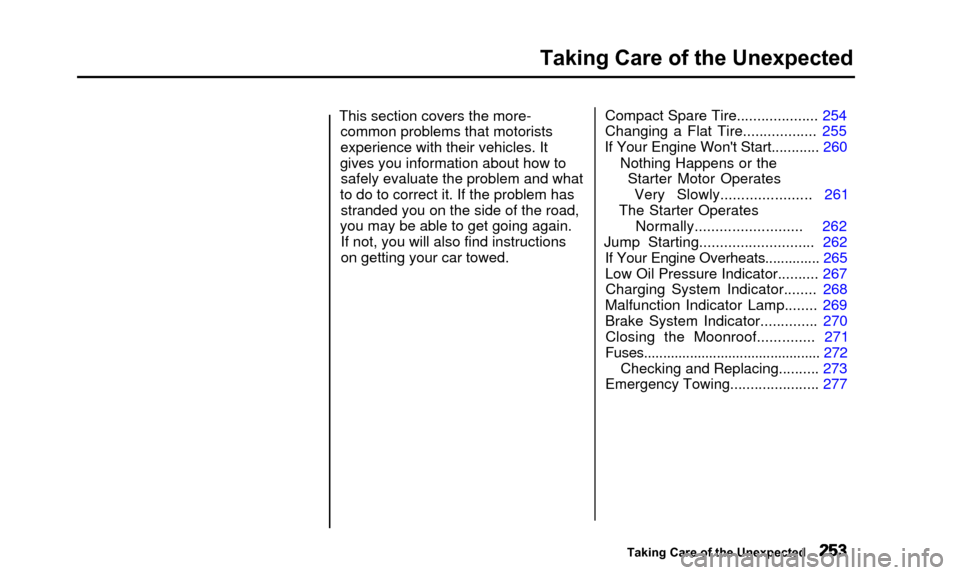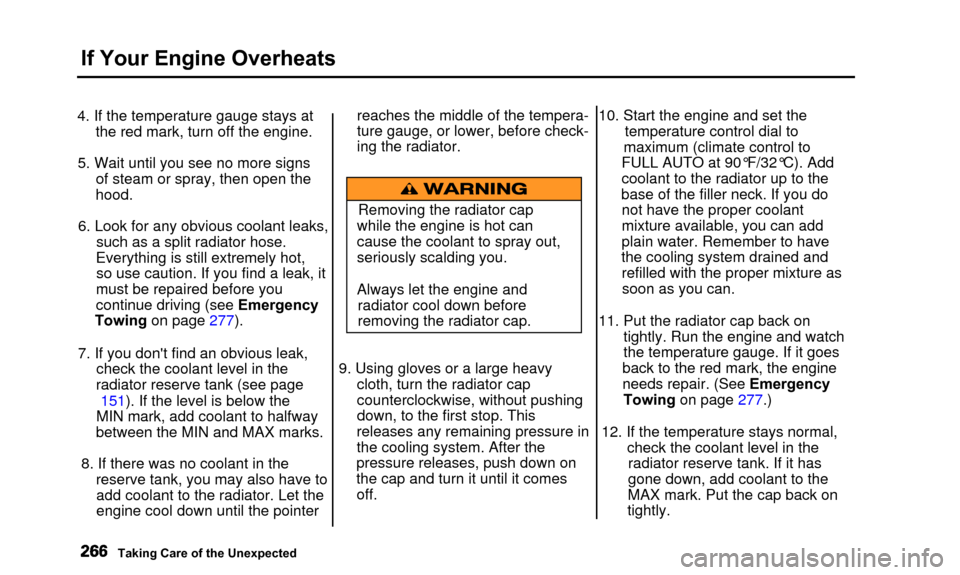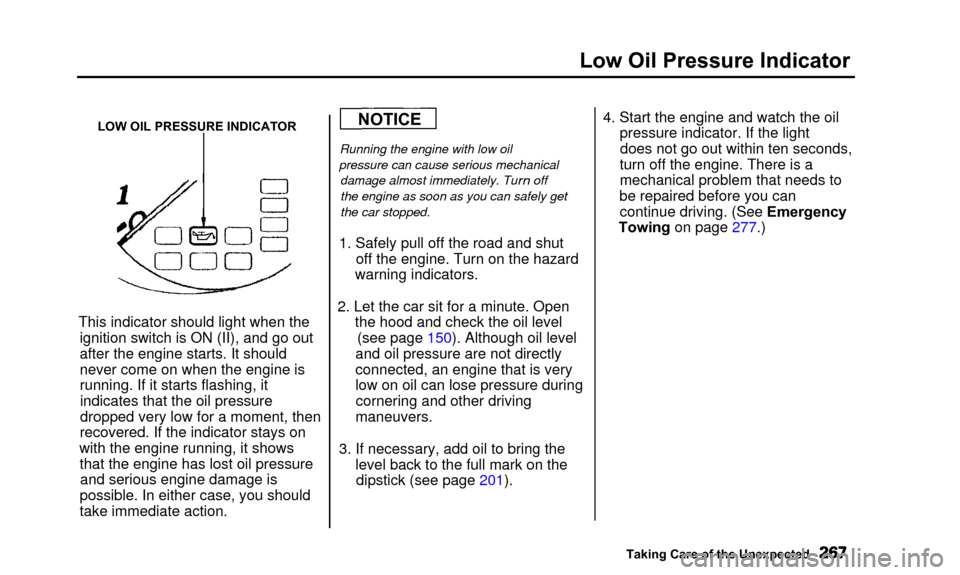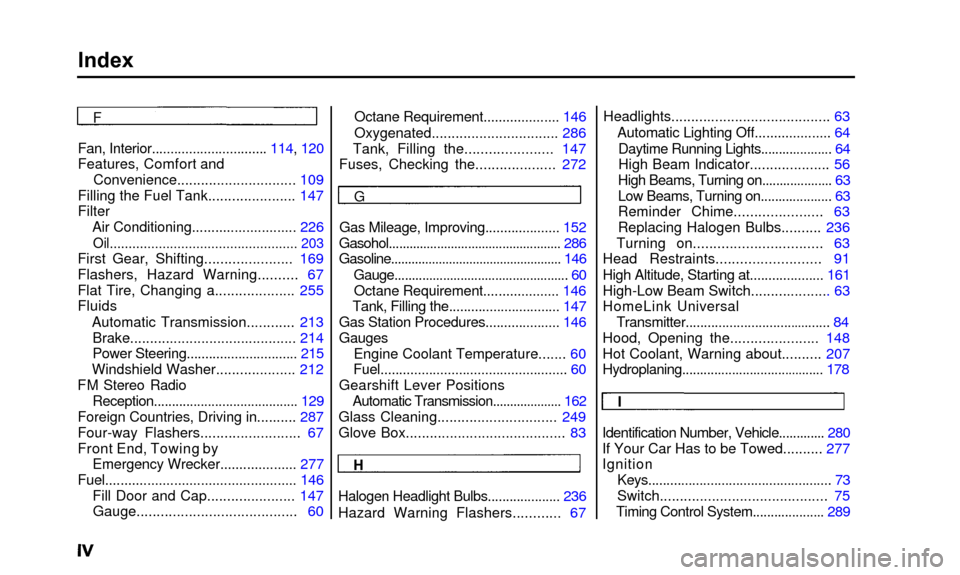emergency towing Acura TL 2000 3.2 Owner's Manual
[x] Cancel search | Manufacturer: ACURA, Model Year: 2000, Model line: TL, Model: Acura TL 2000Pages: 311, PDF Size: 3.05 MB
Page 256 of 311

Taking Care of the Unexpected
This section covers the more-common problems that motorists
experience with their vehicles. It
gives you information about how to safely evaluate the problem and what
to do to correct it. If the problem has stranded you on the side of the road,
you may be able to get going again. If not, you will also find instructions
on getting your car towed. Compact Spare Tire.................... 254
Changing a Flat Tire.................. 255
If Your Engine Won't Start............ 260
Nothing Happens or theStarter Motor OperatesVery Slowly...................... 261
The Starter Operates
Normally.......................... 262
Jump Starting............................ 262
If Your Engine Overheats.............. 265
Low Oil Pressure Indicator.......... 267 Charging System Indicator........ 268
Malfunction Indicator Lamp ........ 269
Brake System Indicator .............. 270
Closing the Moonroof.............. 271
Fuses.............................................. 272
Checking and Replacing.......... 273
Emergency Towing ...................... 277
Taking Care of the Unexpected
Page 264 of 311

If Your Engine Won't Start
Nothing Happens or the Starter
Motor Operates Very Slowly
When you turn the ignition switch to START (III), you do not hear the
normal noise of the engine trying tostart. You may hear a clicking sound
or series of clicks, or nothing at all.
Check these things:• Check the transmission interlock. The transmission must be in Parkor Neutral or the starter will not
operate.
• Turn the ignition switch to ON (II).
Turn on the headlights and check their brightness. If the headlightsare very dim or don't light at all,
the battery is discharged. See
Jump Starting on page 262.
• Turn the ignition switch to START (III). If the headlights do not dim,
check the condition of the fuses. If
the fuses are OK, there is proba-
bly something wrong with the electrical circuit for the ignitionswitch or starter motor. You will
need a qualified technician to determine the problem. (See
Emergency Towing on page 277.)
If the headlights dim noticeably or
go out when you try to start the engine, either the battery is dis-
charged or the connections are
corroded. Check the condition of
the battery and terminal connec- tions (see page 220). You can
then try jump starting the car froma booster battery (see page 262).
Taking Care of the Unexpected
Page 265 of 311

If Your Engine Won't Start, Jump Starting
The Starter Operates NormallyIn this case, the starter motor's
speed sounds normal, or even faster
than normal, when you turn the
ignition switch to START (III), but
the engine does not run.
• Your car has the Immobilizer System. You should use a
properly-coded master or valet key
to start the engine (see page 74).
A key that is not properly coded will cause the immobilizer systemindicator in the dash panel to blink
rapidly.
• Are you using the proper starting procedure? Refer to Starting theEngine on page 161.
• Do you have fuel? Turn the
ignition switch to ON (II) for a
minute and watch the fuel gauge.
The low fuel level warning light may not be working, so you were
not reminded to fill the tank.
• There may be an electrical problem, such as no power to the
fuel pump. Check all the fuses (see page 273).
If you find nothing wrong, you will
need a qualified technician to find
the problem. See Emergency
Towing on page 277. Jump Starting
If your car's battery has run down,
you may be able to start the engine by using a booster battery. Although
this seems like a simple procedure,
you should take several precautions.
A battery can explode if you donot follow the correct procedure,
seriously injuring anyone nearby.
Keep all sparks, open flames,
and smoking materials away
from the battery.
You cannot start your Acura by pushing or pulling it.
Taking Care of the Unexpected
Page 269 of 311

If Your Engine Overheats
4. If the temperature gauge stays atthe red mark, turn off the engine.
5. Wait until you see no more signs of steam or spray, then open the
hood.
6. Look for any obvious coolant leaks, such as a split radiator hose.
Everything is still extremely hot, so use caution. If you find a leak, it
must be repaired before you
continue driving (see Emergency
Towing on page 277).
7. If you don't find an obvious leak, check the coolant level in the
radiator reserve tank (see page
151). If the level is below the
MIN mark, add coolant to halfway
between the MIN and MAX marks.
8. If there was no coolant in the reserve tank, you may also have toadd coolant to the radiator. Let the
engine cool down until the pointer reaches the middle of the tempera-
ture gauge, or lower, before check-
ing the radiator.
Removing the radiator cap
while the engine is hot can
cause the coolant to spray out,
seriously scalding you.
Always let the engine and radiator cool down before
removing the radiator cap.
9. Using gloves or a large heavy cloth, turn the radiator cap
counterclockwise, without pushing
down, to the first stop. This
releases any remaining pressure in
the cooling system. After the
pressure releases, push down on
the cap and turn it until it comes off. 10. Start the engine and set the
temperature control dial to
maximum (climate control to
FULL AUTO at 90°F/32°C). Add
coolant to the radiator up to the
base of the filler neck. If you do not have the proper coolant
mixture available, you can add
plain water. Remember to have
the cooling system drained and refilled with the proper mixture assoon as you can.
11. Put the radiator cap back on tightly. Run the engine and watch
the temperature gauge. If it goes
back to the red mark, the engine
needs repair. (See Emergency
Towing on page 277
.)
12. If the temperature stays normal, check the coolant level in theradiator reserve tank. If it has
gone down, add coolant to the
MAX mark. Put the cap back on
tightly.
Taking Care of the Unexpected
Page 270 of 311

Low Oil Pressure Indicator
LOW OIL PRESSURE INDICATOR
This indicator should light when theignition switch is ON (II), and go out
after the engine starts. It should
never come on when the engine is
running. If it starts flashing, itindicates that the oil pressure
dropped very low for a moment, then
recovered. If the indicator stays on
with the engine running, it shows that the engine has lost oil pressureand serious engine damage is
possible. In either case, you should
take immediate action.
Running the engine with low oil
pressure can cause serious mechanical damage almost immediately. Tu
rn off
the engine as soon as you can safely get
the car stopped.
1. Safely pull off the road and shut off the engine. Turn on the hazard
warning indicators.
2. Let the car sit for a minute. Open the hood and check the oil level(see page 150). Although oil level
and oil pressure are not directly
connected, an engine that is very
low on oil can lose pressure during cornering and other driving
maneuvers.
3. If necessary, add oil to bring the level back to the full mark on thedipstick (see page 201). 4. Start the engine and watch the oil
pressure indicator. If the lightdoes not go out within ten seconds,
turn off the engine. There is a
mechanical problem that needs to
be repaired before you can continue driving. (See Emergency
Towing on page 277.)
Taking Care of the Unexpected
NOTICE
Page 273 of 311

Brake System Indicator
BRAKE SYSTEM INDICATOR
The Brake System Indicator lightcomes on when you turn the ignitionON (II). If the parking brake is not
set, it goes off after you start the
engine. If the parking brake is set, it
goes off when you fully release the parking brake with the engine
running. If it comes on at any other time, it
indicates a problem with the car's
brake system. In most cases, the problem is a low fluid level in the
brake fluid reservoir. Press lightly on
the brake pedal to see if it feels normal. If it does, check the brake
fluid level the next time you stop at a service station (see page 214). If the
fluid level is low, take the car to your dealer and have the brake system
inspected for leaks or worn brake
pads.
However, if the brake pedal does not
feel normal, you should take immediate action. Because of the
brake system's dual-circuit design, a
problem in one part of the system will still give you braking at two
wheels. You will feel the brake pedal
go down much farther before the car
begins to slow down, and you will
have to press harder on the pedal.
The distance needed to stop will be much longer. Slow down by shifting to a lower
gear, and pull to the side of the road
when it is safe. Because of the longer distance needed to stop, it is
hazardous to drive the car. Youshould have it towed, and repaired as
soon as possible. (See Emergency
Towing on page 277.)
If you must drive the car a shortdistance in this condition, driveslowly and cautiously.
Taking Care of the Unexpected
Page 280 of 311

Emergency Towing
If your car needs to be towed, call a
professional towing service or, if you
belong to one, an organization that
provides roadside assistance. Never
tow your car behind another vehicle
with just a rope or chain. It is very dangerous.
There are three popular types of professional towing equipment:
Flat-bed Equipment — The operator
loads your car on the back of a truck.
This is the best way to transport
your Acura.
Wheel-Lift Equipment — The tow
truck uses two pivoting arms that go
under the tires (front or rear) and lift
them off the ground. The other two
tires remain on the ground. This is an acceptable way to tow your
Acura.
Sling-type Equipment — The tow
truck uses metal cables with hooks on the ends. These hooks go around
parts of the frame or suspension and
the cables lift that end of the car off
the ground. Your car's suspension and body can be seriously damaged.
This method of towing is unacceptable.
If your Acura cannot be transported
by flat-bed, it should be towed by
wheel-lift equipment with the front
wheels off the ground. If, due to damage, your car must be towed
with the front wheels on the ground, do the following.
• Release the parking brake.
• Start the engine.
• Shift to D5, then to N.
• Turn off the engine.
Improper towing preparation will
damage the transmission. Follow the
above procedure exactly. If you cannot
shift the transmission or start theengine, your car must be transported
with the front wheels off the ground.
• With the front wheels on the ground, it is best to tow the car no
farther than 50 miles (80 km), and
keep the speed below 35 mph (55
km/h).
CONTINUED
Taking Care of the Unexpected
NOTICE
Page 281 of 311

Emergency Towing
If you decide to tow your car with all
four wheels on the ground, make sure you use a properly-designed and
attached tow bar. Prepare the car for
towing as described above, and leave
the ignition switch in Accessory (I) so the steering wheel does not lock.
Make sure the radio and any items
plugged into the accessory power socket are turned off so they do not
run down the battery.
The steering system can be damaged if
the steering wheel is locked. Leave the ignition switch in Accessory (I), and
make sure the steering wheel turns
freely before you begin towing. Trying to lift or tow your car by the
bumpers will cause serious damage. The bumpers are not designed to
support the car's weight.
Taking Care of the Unexpected
NOTICE
NOTICE
Page 304 of 311

Index
Cold Weather, Starting in.................... 161
Compact Spare.............................. 254
Console Compartment.......... .......... 101
Consumer Information*.......... .......... 292
Controls, Instruments and.................... 52
Coolant
Adding.......................................... 206 Checking........................................ 151
Proper Solution...................... 206
Temperature Gauge.................... 60
Corrosion Protection.......... .......... 250
Crankcase Emissions Control System........................................ 288
Cruise Control Operation.......... .. 69
Customer Relations Office............ 292 Dimming the Headlights.........
........... 63
Dipstick Automatic Transmission.......... .......... 213
Engine Oil.......... .............................. 150
Directional Signals......... ............. 65
Disabled, Towing Your Car If.......... 277
Disc Brake Wear Indicators............ 172
Disposal of Used Oil.......... .......... 205
Doors Power Door Locks......... ............. 77
DOT Tire Quality Grading.......... ..... 284
Drive Belts.......... .............................. 226
Driver and Passenger Safety............ 5
Driving.................................................. 159
Economy........................................ 152
In Bad Weather.......... ............ 178
In Foreign Countries.................... 287 Checking the Fuses.................... 272
Low Oil Pressure Indicator.......... 267
Malfunction Indicator Lamp.... 269
Manually Closing Moonroof.... 271
Overheated Engine..........
.......... 265
Emergency Brake.............................. 99
Emergency Flashers...................... 67
Emissions Controls...................... 288
Engine Belts.......................................... 226
Coolant Temperature Gauge.......... 60
Malfunction IndicatorLamp................................ 54, 269
Oil Pressure Indicator.......... 54, 267
Oil, What Kind to Use.......... .. 201
Overheating.............................. 265
Specifications.......... .................... 283
Ethanol in Gasoline.................... 286
Evaporative Emissions Controls.. 288
Exhaust Fumes......... ..................... 49
Expectant Mothers, Use of Seat Belts by........................................ 18
Exterior, Cleaning the.......... .......... 246
CONTINUED
D
DANGER, Explanation of...
......... ii
Dashboard.............
.............. 52
Daytime Running Lights.......... 64
Dead Battery, What to Do.......... 262
Defects, Reporting Safety.......... 295
DEXRON® in Automatic Transmission Fluid.................. 213
Dimensions....................
...... 282 E
Economy, Fuel.......... 152
Emergencies on the Road.......... 253 Battery, Jump Starting.......... 262Brake System Indicator.......... 270Changing a Flat Tire.......... 255Charging System Indicator.......... 268
Page 305 of 311

Index
Fan, Interior............................... 114, 120
Features, Comfort andConvenience.............................. 109
Filling the Fuel Tank...................... 147
Filter Air Conditioning.......... ................. 226
Oil.................................................. 203
First Gear, Shifting.......... ............ 169
Flashers, Hazard Warning.......... 67
Flat Tire, Changing a.................... 255
Fluids
Automatic Transmission.. .......... 213
Brake.......... ................................ 214
Power Steering.............................. 215
Windshield Washer.................... 212
FM Stereo Radio Reception........................................ 129
Foreign Countries, Driving in.......... 287
Four-way Flashers......................... 67
Front End, Towing by
Emergency Wrecker.................... 277
Fuel.................................................. 146
Fill Door and Cap...................... 147 Gauge........................................ 60 Octane Requirement..........
.......... 146
Oxygenated.......... ...................... 286
Tank, Filling the.......... ............ 147
Fuses, Checking the.......... .......... 272Headlights.......................................
. 63
Automatic Lighting Off.................... 64 Daytime Running Lights......... ........... 64
High Beam Indicator.................... 56
High Beams, Turning on......... ........... 63
Low Beams, Turning on......... ........... 63
Reminder Chime...................... 63
Replacing Halogen Bulbs.......... 236
Turning on......... ....................... 63
Head Restraints.......................... 91
High Altitude, Starting at.......... .......... 161
High-Low Beam Switch......... ........... 63
HomeLink Universal Transmitter.............................
.......... . 84
Hood, Opening the...................... 148
Hot Coolant, Warning about.......... 207
Hydroplaning.............................
........... 178
F
G
Gas Mileage, Improving.......... .......... 152
Gasohol.................................................. 286
Gasoline.................................................. 146
Gauge......... ........................................ . 60
Octane Requirement.......... .......... 146
Tank, Filling the.......... .................... 147
Gas Station Procedures.................... 146
Gauges
Engine Coolant Temperature... .... 60
Fuel................................................. . 60
Gearshift Lever Positions Automatic Transmission.................... 162
Glass Cleaning.............................. 249
Glove Box....................................... . 83
H
Halogen Headlight Bulbs.................... 236
Hazard Warning Flashers.......... .. 67I
Identification Number, Vehicle............. 280
If Your Car Has to be Towed.......... 277
Ignition
Keys................................................. . 73
Switch......................................... . 75
Timing Control System.......... .......... 289